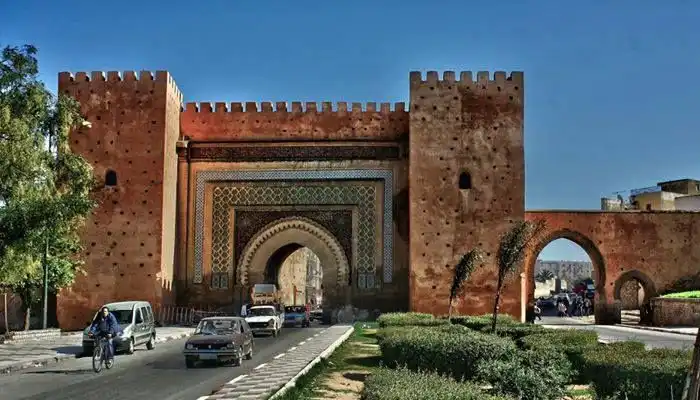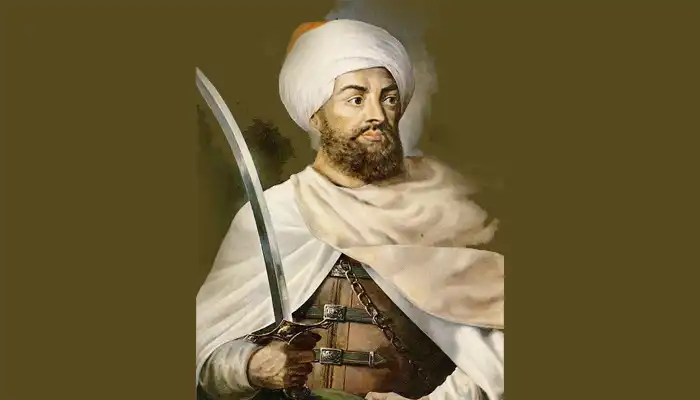Discover Meknes Attractions and Hidden Gems
Introduction
Meknes, one of Morocco’s historic imperial cities, is a treasure trove of cultural and architectural marvels, with Meknes attractions ranging from monumental gates to vibrant souks and grand palaces. Once the capital during Sultan Moulay Ismail’s reign, the city boasts a rich legacy that highlights its pivotal role in Morocco’s history. Designated as a UNESCO World Heritage site, Meknes is celebrated for its seamless blend of Islamic and European influences.

This guide takes you on a journey through Meknes’ most captivating attractions. From exploring the historic medina to admiring architectural wonders like Bab Mansour and the Mausoleum of Moulay Ismail, you’ll uncover the city’s unique charm and significance. Whether you’re a history enthusiast, a culture lover, or a curious traveler, Meknes promises an unforgettable experience.
1. Discovering the Heart of Meknes: The Historic Medina
At the core of Meknes lies its historic medina, a vibrant maze of narrow alleys brimming with life, history, and culture. Designated as part of Meknes’ UNESCO World Heritage status, the medina offers a window into the city’s enduring heritage. Traditional souks, where local artisans showcase their skills, form the heartbeat of this dynamic area.

1.1 Vibrant Souks and Artisan Crafts
Visitors can explore stalls filled with intricate pottery, handmade crafts, and vibrant spices, immersing themselves in the city’s cultural essence. The medina’s markets are an ideal place to find authentic Moroccan souvenirs, from colorful ceramics to fragrant saffron.
1.2 Architectural Charm and Hidden Courtyards
The medina’s architectural charm is equally compelling. Its centuries-old buildings, adorned with carved wood and zellij tilework, offer glimpses into Meknes’ storied past. Hidden courtyards provide quiet sanctuaries amidst the bustling alleys, adding to the medina’s allure.
2. Bab Mansour: Gateway to Imperial Grandeur
Standing proudly at the entrance of the medina, Bab Mansour is Meknes’ most iconic landmark. Renowned for its exquisite design and historical significance, this monumental gate is a masterpiece of Moroccan architecture. Built during the reign of Sultan Moulay Ismail, its intricate zellij tilework, grand arches, and detailed carvings showcase the artistic brilliance of the era.

2.1 A Symbol of Power and Prestige
Bab Mansour served as a ceremonial entrance to the imperial city, symbolizing the wealth and power of Moulay Ismail’s reign. Its grandeur reflects Meknes’ golden age and continues to inspire awe among visitors.
2.2 Starting or Ending Your Journey
Today, Bab Mansour remains a favorite spot for visitors, offering a stunning backdrop for photos and a perfect entry or exit point for exploring the medina. Its timeless beauty makes it a must-see for anyone visiting Meknes.
3. Honoring History: The Mausoleum of Moulay Ismail
A visit to the Mausoleum of Moulay Ismail is a journey into the legacy of one of Morocco’s most influential rulers. As the final resting place of the sultan who transformed Meknes into an imperial capital, this site is both a historical and cultural landmark.

3.1 Open to All Visitors
One of the few religious sites in Morocco open to non-Muslim visitors, the mausoleum offers a rare opportunity to experience its serene beauty and historical significance.
3.2 Artistry and Tranquility
The structure’s intricate zellij tilework, ornate plaster carvings, and tranquil courtyards highlight the artistry of Moroccan craftsmanship. Its peaceful ambiance makes it a must-visit for anyone exploring Meknes.
4. Immersing Yourself in Local Life: Meknes’ Souks and Markets
The bustling souks of Meknes offer an authentic glimpse into Moroccan culture and tradition. These lively markets are where the city’s vibrant energy truly comes alive, as artisans, traders, and shoppers gather to barter and exchange goods. From handcrafted pottery to aromatic spices, the souks are a treasure trove for those seeking unique souvenirs and an immersive cultural experience.
4.1 Traditional Crafts and Unique Finds
Meknes’ souks are renowned for their beautifully handcrafted items. Visitors can browse stalls filled with intricate ceramics, leather goods, and delicately woven textiles. Each piece reflects the rich artistry of the region, making the souks an ideal place to find keepsakes that tell a story.

4.2 The Art of Haggling
Shopping in the souks is as much about the experience as it is about the purchases. Engaging in the age-old tradition of haggling adds an exciting element to the visit, offering travelers a chance to connect with local vendors while discovering hidden gems.
5. Witnessing Architectural Ingenuity: The Royal Stables and Granaries
The Royal Stables and Granaries of Meknes are a testament to the logistical brilliance of Sultan Moulay Ismail’s reign. These vast structures, built to house and feed thousands of the sultan’s prized horses, highlight the grandeur and military prowess of the Alaouite dynasty.

5.1 The Vision of Sultan Moulay Ismail
Designed with precision, the granaries feature thick walls and advanced ventilation systems, ensuring the preservation of grain and other supplies. This ingenuity reflects the sultan’s ambition to establish Meknes as a formidable imperial city.

5.2 A Historical Marvel
Walking through the towering stables and granaries, visitors can sense the scale of the sultan’s vision. These structures not only demonstrate impressive engineering but also offer a glimpse into the strategic planning that defined Meknes’ golden age.
6. Beyond Meknes: Exploring Volubilis and Moulay Idriss
For those eager to explore beyond the city, Meknes serves as a gateway to two of Morocco’s most significant historical and cultural sites: the ancient Roman city of Volubilis and the sacred town of Moulay Idriss. These destinations, both within easy reach of Meknes, offer a deeper understanding of Morocco’s diverse heritage.

6.1 Volubilis: A Step Back in Time
Volubilis is one of the best-preserved Roman archaeological sites in Morocco. Wander through its ancient ruins to admire intricate mosaics, towering columns, and grand arches. Each corner of this UNESCO World Heritage site tells a story of Morocco’s connection to the Roman Empire.
6.2 Moulay Idriss: A Spiritual Retreat
Perched on a hilltop, Moulay Idriss is a picturesque town named after the founder of Morocco’s first dynasty. Its spiritual significance, coupled with breathtaking views of the surrounding countryside, makes it a peaceful retreat for travelers seeking a serene day trip.

6.3 Planning Your Day Trip
Visiting both Volubilis and Moulay Idriss in one day is a convenient and enriching experience. Accessible by car or guided tours, these sites complement your exploration of Meknes by offering insights into Morocco’s ancient and spiritual past.
7. Savoring the Flavors of Meknes: Food and Cuisine
Meknes is not only a city of historical grandeur but also a destination for culinary discovery. Its vibrant food scene offers a delightful mix of traditional Moroccan flavors, street food delicacies, and refined dining experiences. Whether you’re sampling dishes at local eateries or enjoying street vendors’ offerings, Meknes provides a feast for the senses.

7.1 Traditional Dishes to Try
The city’s culinary highlights include signature Moroccan dishes like tagine, a slow-cooked stew infused with aromatic spices, and couscous, a cherished staple often served with tender meats and seasonal vegetables. Visitors can also savor local variations of harira soup and grilled brochettes, which reflect Meknes’ unique flavor profile.
7.2 Street Food and Local Markets
For a more casual experience, Meknes’ bustling food markets and street vendors offer quick and flavorful bites. Sample msmen (a flaky Moroccan pancake) with honey or freshly grilled sardines that highlight the region’s culinary traditions. Exploring these vibrant food hubs provides an authentic taste of Meknes’ everyday life.
7.3 Dining Experiences
Meknes also boasts a selection of traditional restaurants and riads where visitors can indulge in multi-course Moroccan meals in an intimate setting. Dining at these establishments often comes with the added charm of atmospheric courtyards and live music, enhancing the overall experience.
8. Preserving a Legacy: Meknes’ UNESCO World Heritage Status
Meknes holds a prestigious place on the list of UNESCO World Heritage sites, a designation it earned in 1996 for its outstanding cultural and architectural significance. This recognition reflects the city’s role in preserving Morocco’s imperial history and its unique blend of Islamic and European influences.

8.1 What Makes Meknes UNESCO-Worthy
The city’s designation stems from its exceptional architectural heritage, which includes monumental gates like Bab Mansour, the historic medina, and impressive structures such as the Royal Stables. These sites exemplify the ambitious vision of Sultan Moulay Ismail, whose reign defined Meknes as an imperial capital.
8.2 A Living Legacy
Meknes continues to honor its rich history by maintaining and preserving its historic landmarks. Walking through the medina or visiting its grand palaces allows travelers to connect with the city’s storied past while witnessing its modern vibrancy. UNESCO recognition ensures these treasures are protected for future generations.
Conclusion
Meknes is a city where history, culture, and architecture converge to create a truly unforgettable destination. From the vibrant medina and iconic Bab Mansour to the serene Mausoleum of Moulay Ismail and nearby treasures like Volubilis, Meknes offers something for every traveler. Its recognition as a UNESCO World Heritage site underscores its importance in preserving Morocco’s imperial legacy, making it an essential stop on any journey through the country.






